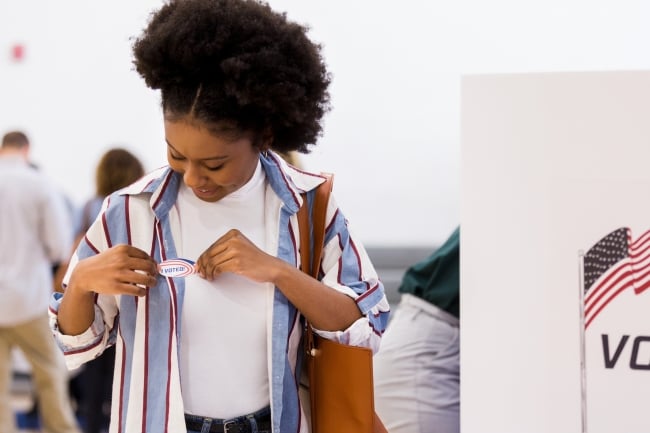You have /5 articles left.
Sign up for a free account or log in.

College students say the upcoming election and political discourse on campus are impacting their mental health. Counseling professionals share ideas for helping students manage stress and anxiety around the election.
SDI Productions/E+/Getty Images
Supporting students’ freedom of speech and their overall health and wellness is one challenge college leaders are navigating this fall as the presidential election creeps closer. Three college administrators weighed in on supporting students through uncertainty and some of the strategies institutions can implement in a Sept. 19 webinar by TimelyCare.
Students Say
A July survey, administered before Kamala Harris was announced as the Democratic nominee, from TimelyCare found 65 percent of students felt stressed or anxious about the upcoming election, and 52 percent said engaging in political dialogue on campus was affecting their mental health.
What’s the sitch: Today’s college students are highly engaged in politics and plan to vote in the election, but being vocal about their beliefs with their peers feels difficult.
A September poll by the National Society of High School Scholars found 83 percent of Gen Z plans to vote in the November election. Gallup polled Americans in August and found 74 percent have given “quite a lot” of thought to the election, a record number since 2008.
However, one-third of young adults (ages 18 to 29) say they don’t feel comfortable sharing their political views on campus, for fear of negative repercussions, according to the most recent Harvard Youth Poll.
Many students are having challenges coping with the uncertainty of the November elections, and that’s been reflected within student government elections or smaller campuses spaces as well, Makini Austin, director of the wellness center at Agnes Scott College, said in the webinar. Administrators are caught trying to promote civic engagement while also addressing student mental health concerns and anxieties.
For students: Experts agree that students should consider their behaviors and how to promote healthy living and connections across campus. That could look like:
- Staying connected. Students have a tendency to isolate in overwhelming situations, but engaging with others and maintaining connections is so important to mental health, Austin explained. Peer groups, student organizations or group therapy sessions can build community and promote healthy practices.
- Establishing boundaries. When caught in stressful situations, such as conflict or hostile discourse, students don’t have to engage but can instead respect others’ opinions and walk away with mutuality, said Vanessa Jenkins, executive director of health and wellness at Norfolk State University. “You don’t have to sit there and prove yourself [or] feel like you have to have that last word.”
- Limiting news consumption. While being an informed voter is an important piece of civic engagement, students can identify specific channels through which they receive their news or establish times when they consume news media so they don’t feel overwhelmed by content, said Shane Chaplin, executive director of counseling and psychological services at Carnegie Mellon University. That could look like only checking news apps for a few hours each day or selecting a few trusted news sources to engage with.
- Practicing mindfulness. Identifying ways for students to ground themselves and reduce anxieties can help build resilience in the face of larger stressors, such as the election. This could include going on a walk or finding a soothing space.
- Teaching peaceful discourse. Sometimes students enter dialogue with strong emotions, which can be counterproductive to the points they’re trying to articulate, Austin shared: “Start with a feather, even if you have to end with a hammer. Even if you’re on the same side or share similar ideologies, if you approach it in a specific way, you can still find yourself at odds.” Listening with respect and empathy can be one way all voices can be heard, Chaplin said.
- Setting routines. It can be more difficult to identify when a student is out of sync with their wellness in the absence of a routine, because everything feels more disruptive, Austin noted. Creating intentional yet realistic goals and practices can improve students’ overall health and well-being.
- Knowing when to seek help. If students have exhausted their resources or see that mental health concerns are impacting their day-to-day lives, that should be an indicator that they need to seek professional care.
In practice: For those working in higher education looking to create systems or programs that support students throughout a stressful time, the administrators recommended the following actions.
- Expanding safe spaces. No matter how the election plays out this fall, past elections have been disruptive and upsetting to students. Counseling centers and other groups on campus should consider how to facilitate places for students to seek and receive care.
- Breaking silos. Partnering across campus with other units can model how the institution can support students and expand a culture of care. Expanding care from beyond the counseling center can normalize the feelings students and other campus community members are feeling around political uncertainty.
- Emphasizing connections. A centralized hub for student events and activities can help connect learners who want to build relationships with their peers but are unsure of where to start. Administrators can sometimes forget, year after year, that this is an area students need help in, so putting that information front and center is key, Austin said.
We bet your colleague would like this article, too. Send them this link to subscribe to our weekday newsletter on Student Success.








